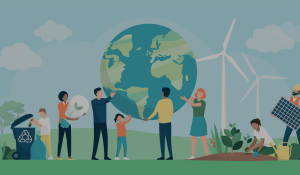
When Ethan Merlin, a school teacher and Green America member in Rockville, MD, had an opportunity to take a group of students to visit Moscow, he had just one regret: by flying roundtrip across the Atlantic, he and his students would have no choice but to each cause the emission of more than three tons of carbon dioxide, a greenhouse gas.
“The trip was an amazing learning experience for me and for my students,” says Merlin. “But I also care about the climate crisis, and the world that we are leaving for future generations.”
So rather than forego the trip altogether, Merlin helped mitigate the climate impact of the students' trip by purchasing carbon offsets equivalent to the greenhouse gas emissions associated with their airplane flights.
"I was so glad [to discover this option,]" he says.
Carbon offsetting provides a powerful way to address climate change. By purchasing offsets, you help fund a project that prevents one ton of greenhouse gases (GHGs) from being emitted for each ton that you have caused. Carbon offset providers sell the GHG reductions associated with projects like wind farms or methane-capture facilities to customers who want to offset the emissions they caused by flying, driving, or using electricity.
For example, Big Tree Climate Fund sells offsets to consumers from a methane-reduction project in Brazil. The Irani Project, located at a paper and pulp factory in the city of Vargem Bonita, treats wastewater from the plant in a special way, so it degrades aerobically (like compost) instead of anaerobically (like landfill waste). Anaerobic wastewater treatment produces massive amounts of climate-warming methane; according to Big Tree, businesses around the world emit 33 to 44 million tons of methane through anaerobic wastewater treatment each year. Methane is 23 times more potent as a greenhouse gas than carbon dioxide, according to the EPA. Because of the innovative methane-reducing technology it uses, the Irani Project has reduced its methane emissions by nearly 56,000 tons each year. It also reduces the paper mill's water use.
Over the past few years, the carbon offset market has grown rapidly, directing $705 million in 2008 to carbon-reducing projects worldwide. As the market has expanded, it has also matured—and finding a trustworthy offset provider is easier than ever.
Before you turn to offsets, it’s important to reduce your climate impact first (see box, below). A good mantra when it comes to reducing your carbon footprint is: reduce what you can, offset the rest, and then repeat. Once you’ve taken steps to shrink your emissions, follow these steps to offset what’s left. ...
Do the Math
The first step to offsetting your climate impact is to calculate how many tons of GHGs your activities emit. Most offset retailers provide online calculators (see “Resources,” below). Their estimates will come in about the same, with one exception: there is an ongoing controversy about the climate impact of air travel. In addition to the carbon dioxide that planes emit directly, they leave behind other emissions that ultimately contribute to global warming, in a phenomenon known as “radiative forcing.”
Some carbon calculators multiply a flight’s emissions by a radiative forcing index (RFI), but unfortunately, they multiply by a factor of anywhere between about one-and-a-half and three, resulting in different totals.
So what’s an eco-conscious traveler to do? Until a uniform RFI is in place, it’s best to err on the side of too much offsetting, rather than too little—after reducing your air travel as much as possible. Use a carbon calculator that incorporates a radiative forcing index, like those from offsetters in the resources box. If a carbon calculator offers a check-box to “include radiative forcing” in its calculations, choose this option.
Look for Certified Offsets
Because you can’t see or touch a reduction of greenhouse gases, it’s important to know exactly what reduction you are purchasing, and that the reduction wouldn’t have happened without your purchase. The leading offset providers have developed shared standards for carbon offsets, and their offsets are verified by independent third parties, providing assurance that you’re getting what you paid for.
Look for offset providers that have met the standards of the International Carbon Reduction and Offset Alliance (ICROA) or the Green-e Climate program. Both the Alliance and Green-e Climate require their member retailers to ensure that any reduction in GHGs sold as a carbon offset is “real, verified, permanent, additional, and unique.” (Visit www.icroa.org or www.green-e.org for a fuller definition of each criterion.) The Alliance’s members source their offsets from projects that would not have been implemented without offset funding and that have been certified to meet the above criteria by one of five standards: the Clean Development Mechanism, Joint Implementation, the Gold Standard, the Voluntary Carbon Standard, or the Climate Action Reserve.
Choose a Carbon-Busting Project
Once you know how many tons of GHGs you’ve added to the atmosphere, select a certified offset that will reduce GHGs by the same amount. Your offset purchases can support a variety of carbon-reducing projects.
Renewable energy generation: More than half of offset purchases worldwide support renewable energy projects, which help to displace coal-fired electricity. Look for offsets certified to have caused new GHG reductions that wouldn’t have happened otherwise. For example, 3Degrees offers Green-e Climate certified offsets from wind facilities in northeastern China and Karnataka, India. Buying these offsets contributes to the viability of these projects, and you are buying new energy generation that is never resold, displacing coal power and reducing emissions in rapidly developing countries. Or, NativeEnergy’s WindBuilders program sells offsets to finance new wind projects. Many promising projects lack the capital they need to get built. So by purchasing a carbon offset that finances new construction, you help build wind farms and solar installations.
Methane projects: Another category of offset products helps prevent the release of methane, a particularly potent greenhouse gas which has over 20 times the impact of CO2. For example, TerraPass offsets support methane capture at landfills from Maine to South Dakota.
Energy efficiency and other projects: Offset dollars can also support other creative projects that reduce GHG emissions. For example, the CarbonNeutral Company offers offsets from a project to install compact fluorescent light bulbs and other energy-saving devices in hotels throughout Jamaica.
Forestry: In the past, Real Green has urged readers to steer clear of carbon offsets based on tree-planting projects (though trees have lots of other environmental benefits). Trees certainly do “breathe in” carbon dioxide, but it doesn’t make sense to offset emissions from a recent flight by planting trees that only remove that much CO2 from the air over many decades. The good news is that several of the leading offset project standards have developed clear criteria for forestry-based offsets whose GHG reductions will occur on a more immediate timeframe. Some reputable offsets based on forestry projects are available from the ICROA-member offset retailers (listed in the “Resources,” below).
Look for a Reputable Carbon Offset
If you’re a conscientious consumer who tries to live a low-emission lifestyle, consider offsetting the remaining emissions for which you are responsible. Buying offsets will help you direct much-needed capital to worthy projects that will keep greenhouse gases out of the atmosphere.
Then, return to the beginning of the reduce-offset-repeat cycle, and continue looking for ways to reduce the climate impact of your household, workplace, neighborhood, and community.
Reduce Your Impact First
Purchasing carbon offsets only makes sense for those who have already reduced their emissions by flying less, driving less, eating less meat, and curbing electricity use. For guidance from Real Green on reducing your climate impact, check out our archives.
For a comprehensive guide to cutting your home electricity use in half over the next five years, download the Efficiency First! issue of our magazine.
Offsets vs. RECs
Warning: Don't purchase renewable energy credits (RECs) as offsets.
Why? When you buy an offset, you should know for sure that your purchase caused a new reduction in greenhouse gas emissions that wouldn’t have happened otherwise, and not all renewable energy qualifies. RECs are typically sold from existing projects to give electricity customers a green power option. But renewable energy that customers purchase to offset their GHG emissions is held to a different standard. Buying a REC does not ensure that your purchase caused a measurable reduction in greenhouse gas emissions that wouldn’t have happened otherwise.
To buy carbon offsets sourced from renewable energy projects, look for an offset from an ICROA member or search Green-e Climate’s “Find Certified Carbon Offsets” page for certified renewable energy offsets. These offsets can result from new renewable energy projects, but only those that are beyond business as usual.







